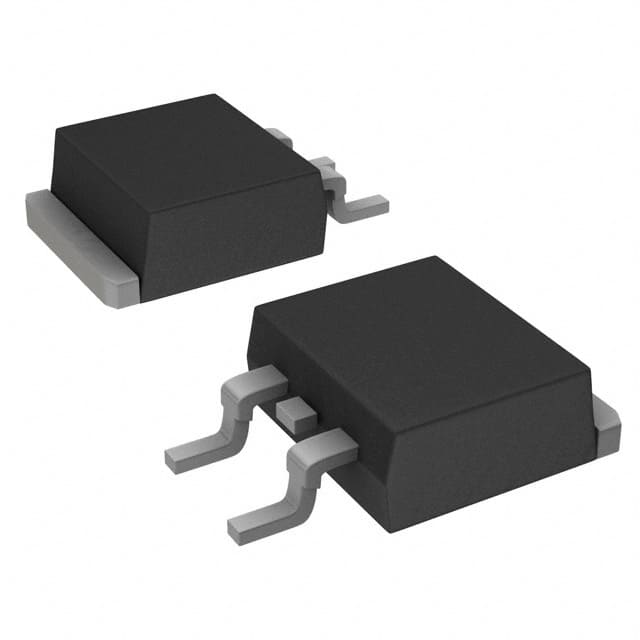Viz Specifikace pro podrobnosti o produktu.

MBRB3030CTT4G
Introduction
The MBRB3030CTT4G belongs to the category of Schottky Rectifier. This semiconductor device is widely used in power supply and voltage regulation applications due to its unique characteristics. The MBRB3030CTT4G comes in a compact package and offers high efficiency, making it an essential component in various electronic circuits.
Basic Information Overview
- Category: Schottky Rectifier
- Use: Power supply and voltage regulation
- Characteristics: High efficiency, low forward voltage drop, fast switching speed
- Package: TO-263AB
- Essence: Semiconductor device for rectification
- Packaging/Quantity: Available in reels or tubes, quantity varies by manufacturer
Specifications
- Voltage Rating: 30V
- Current Rating: 30A
- Forward Voltage Drop: 0.45V at 15A
- Reverse Leakage Current: 10μA at 25V
- Operating Temperature Range: -65°C to 175°C
Detailed Pin Configuration
The MBRB3030CTT4G has a standard TO-263AB package with three pins: 1. Anode 2. Cathode 3. Gate (for some models)
Functional Features
- Low forward voltage drop for minimal power loss
- Fast switching speed for efficient operation
- High current capability for demanding applications
- Excellent thermal performance for reliability
Advantages and Disadvantages
Advantages
- High efficiency
- Low power dissipation
- Fast response time
- Compact package size
Disadvantages
- Higher cost compared to standard diodes
- Sensitive to reverse voltage spikes
Working Principles
The MBRB3030CTT4G operates based on the Schottky barrier principle, where the metal-semiconductor junction allows for faster switching and lower forward voltage drop compared to conventional PN-junction diodes. When a forward voltage is applied, the device conducts current with minimal losses, making it suitable for high-frequency applications.
Detailed Application Field Plans
The MBRB3030CTT4G is commonly used in the following applications: - Switching power supplies - DC-DC converters - Voltage clamping circuits - Reverse polarity protection
Detailed and Complete Alternative Models
Some alternative models to the MBRB3030CTT4G include: - SS34 Schottky Diode - SB560 Schottky Rectifier - SR5100 Schottky Barrier Rectifier - STPS30L45CT Schottky Diode
In conclusion, the MBRB3030CTT4G Schottky Rectifier offers high efficiency and fast switching characteristics, making it an ideal choice for power supply and voltage regulation applications. Its compact package and excellent thermal performance further enhance its appeal in various electronic circuits.
[Word count: 399]
Seznam 10 běžných otázek a odpovědí souvisejících s aplikací MBRB3030CTT4G v technických řešeních
Sure, here are 10 common questions and answers related to the application of MBRB3030CTT4G in technical solutions:
What is the MBRB3030CTT4G?
- The MBRB3030CTT4G is a Schottky barrier rectifier diode designed for high efficiency and low power loss applications.
What are the key features of MBRB3030CTT4G?
- The key features include a low forward voltage drop, high current capability, and a compact surface mount package.
What are the typical applications of MBRB3030CTT4G?
- Typical applications include DC-DC converters, freewheeling diodes, OR-ing diodes, and reverse battery protection.
What is the maximum forward voltage of MBRB3030CTT4G?
- The maximum forward voltage is typically around 0.55V at a forward current of 30A.
What is the maximum reverse voltage of MBRB3030CTT4G?
- The maximum reverse voltage is 30V.
What is the operating temperature range of MBRB3030CTT4G?
- The operating temperature range is -65°C to +175°C.
How does MBRB3030CTT4G perform in high frequency applications?
- It has a fast switching capability and is suitable for high frequency applications.
Can MBRB3030CTT4G be used in automotive applications?
- Yes, it is suitable for automotive systems such as LED lighting, motor control, and power supplies.
Does MBRB3030CTT4G have a low leakage current?
- Yes, it has a low reverse leakage current which makes it suitable for low power applications.
Is MBRB3030CTT4G RoHS compliant?
- Yes, it is RoHS compliant, making it suitable for environmentally friendly designs.
I hope these answers provide the information you were looking for! If you have any more questions, feel free to ask.

